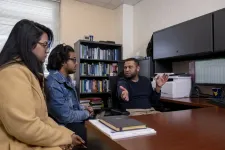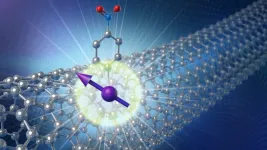(Press-News.org) In August 2022, Congress passed the Inflation Reduction Act (IRA). Signed by President Joe Biden, the legislation attempted to curb inflation, lower the deficit, and invest heavily into domestic clean energy.
One aspect of the bill was setting a market value-based target for battery-critical mineral content in electric vehicles (EVs). By 2027, for an EV to be tax-credit eligible, 80 percent of the market value of critical minerals in its battery must be extracted or processed domestically or by US free-trade partners (FTPs).
While this goal is well-intended, there are reasons to believe the mandate is unreachable and could create new problems.
In a commentary published March 6 in the journal Nature Sustainability, Northwestern Engineering professor Jennifer Dunn and PhD student Jenna Trost determined the 80-percent target could be achievable for some types of batteries for plug-in hybrid vehicles, but meeting demand for fully electric vehicles with batteries that meet IRA criteria would be challenging. Instead, a mass-based target could avoid some of the challenges posed by a market-value target, such as pinning down a consistent market value for each mineral when market prices are volatile.
Dunn and Trost also concluded the approach taken by the IRA discounts the environmental effects of mining, non-critical minerals supply, and definitions that avoid gamesmanship.
Below are three takeaways from their paper.
The rise of unintended consequences
To meet the demands of the bill, a steep increase in domestic mining would be needed. That could pose environmental issues, including water pollution, in addition to creating greenhouse gas emissions from burning fuel to operate mining equipment.
Building mines, Dunn said, can take up to a decade. Permitting processes to protect the environment and worker safety can create delays and extend that timeline. Communities may also resist new mines because of the potential environmental impact. Establishing a domestic supply of minerals is unlikely to meet the IRA’s aggressive timeline.
“There's a lot of interesting social and political dynamics. Some people don't want new or expanded mines, and others welcome the economic activity and the opportunity to become more energy independent by building out a domestic minerals supply chain,” said Dunn, associate professor of chemical and biological engineering and director of the Center for Engineering Sustainability and Resilience. “It’s fascinating to watch how this is going to play out.”
Much of the mineral supply chain will continue to be international. As a result, there’s also the issue of labor laws in countries that are not FTPs, raising the question of responsible sourcing.
One example is Argentina, a non-FTP country that provided 59 percent of the 2,618 tons of lithium mineral the US imported in 2019. Argentina does not offer the labor and environmental protections the US requires of FTP partners, but any minerals acquired from the country would still count if they were processed domestically. Dunn and Trost argue that guidance should be provided regarding what constitutes processing, and what are allowable sources for the minerals that would be processed in the US or an FTP.
“We have ostensibly good labor protections for miners, but that's not the case everywhere. What are the ethical implications of using minerals from other places?” Dunn said. “And then, are we going to be really serious about recycling, because we're clearly not with plastics? We have to be really serious. Investment in battery recycling is growing, but it still needs to be larger.”
Trost brought up another point.
“In addition to the environmental issues, there are social issues to consider, like migration and loss of livelihood,” Trost said. “Mining might cause people to move off their land and strip them of their homes, livelihoods, and culture. It’s a multi-faceted problem that's really interesting and really pressing.”
Why mass-based would be better than market-based
Dunn and Trost raised four concerns about the use of a market value-based target:
A market value-based target can be met before all the critical minerals in a battery are acquired from a secure source such as the US or an FTP, depending on the battery chemistry.
The environmental effects of critical minerals acquisition are physically tied to the amount of mineral produced rather than its market value.
Market values fluctuate. Dunn and Trost note that prices for cobalt and nickel, for example, have increased by about $13,000 and $4,000 per metric ton, respectively, since 2019.
Many non-critical minerals central to batteries are mainly produced outside the US, raising supply risks.
Instead, the authors suggested using a mass-based standard. Using a mass-based target, they wrote, would reduce uncertainty and hold all automakers to the same standard in the interpretation of market value.
“Given the fluctuations in mineral market values, using a mass-based target in the policy could improve its transparency but may not incentivize production of high-value minerals domestically, which is important for mineral security,” Dunn and Trost wrote.
Deliberation is good
When it was passed last summer, the IRA was meant to address crushing inflation and deliver a political win for the Biden administration. As for some of the environmental concerns, Dunn and Trost think a slower process would have allowed some of the finer points of the bill to be more fully developed.
“It’s hard to design policy well in a hurry that holistically considers the social and environmental effects of the minerals supply chain,” Dunn said. “It’s important to leverage the potential of electric vehicles to reduce emissions from cars, but when we design policies to encourage their use, we need to take a holistic view that helps us get off on the right foot with establishing a low-environmental impact, safe, and ethical mineral supply chain.”
To stress that holistic view, Dunn is leading a Global Engineering Trek for undergraduates next fall to Santiago, Chile. Chile is one of the world’s top two lithium suppliers, and Dunn wants students to learn about the extraction process and understand the costs and benefits of mining.
“We want Northwestern students to understand this is a global issue. There are people on the ground in these mining communities who are experiencing the negative effects of expanded mining,” Dunn said. “As engineers, when we design materials for batteries or anything else, we need to think about where the materials are coming from. Could I use less of it? Could I use a different material? Can I design it for recycling so it's easy to get it back? We're thinking about this holistically. We want to give students experiences that bring home the importance of these design choices for people along the supply chain as well as the immediate technology user.”
END
The challenges of mining for electric-vehicle batteries
Jennifer Dunn and Jenna Trost wrote a commentary for Nature Sustainability
2023-03-06
ELSE PRESS RELEASES FROM THIS DATE:
AI chatbot ChatGPT mirrors its users to appear intelligent
2023-03-06
LA JOLLA (March 6, 2023)—The artificial intelligence (AI) language model ChatGPT has captured the world’s attention in recent months. This trained computer chatbot can generate text, answer questions, provide translations, and learn based on the user’s feedback. Large language models like ChatGPT may have many applications in science and business, but how much do these tools understand what we say to them and how do they decide what to say back?
In new paper published in Neural Computation on February 17, 2023, Salk Professor Terrence Sejnowski, ...
Advancing engineering
2023-03-06
(Santa Barbara, Calif.) — UC Santa Barbara professors Thuc-Quyen Nguyen and Carlos G. Levi are among 106 new members of the National Academy of Engineering. Academy membership honors those who have made outstanding contributions to “engineering research, practice or education, including, where appropriate, significant contributions to the engineering literature” and to “the pioneering of new and developing fields of technology, making major advancements in traditional fields of engineering, or developing/implementing innovative approaches to engineering education.”
“Our campus ...
Microscopic chalk discs in oceans play a key role in earth’s carbon cycle by propagating viruses
2023-03-06
A Rutgers-led team of scientists studying virus-host interactions of a globally abundant, armor-plated marine algae, Emiliania huxleyi, has found that the circular, chalk plates the algae produce can act as catalysts for viral infection, which has vast consequences for trillions of microscopic oceanic creatures and the global carbon cycle.
“In a drop of seawater, there will be about 1,000 to 10,000 E. huxleyi cells, and about 10 million viruses,” said Kay Bidle, a professor in the Department of ...
WVU water quality expert develops public tool for diagnosing health of America’s streams
2023-03-06
A model for predicting the levels of oxygen in water, developed by West Virginia Universityresearcher Omar Abdul-Aziz, gives citizen scientists nationwide a tool for taking action on stream pollution.
“I have been looking at water quality data for 20 years,” said Abdul-Aziz, an associate professor at the Benjamin M. Statler College of Engineering and Mineral Resources. “I can tell you that a big percentage of streams in the United States are polluted. Urban streams are getting dumpster runoff, stormwater ...
Iron & the brain: Where and when neurodevelopmental disabilities may begin during pregnancy
2023-03-06
The cells that make up the human brain begin developing long before the physical shape of the brain has formed. This early organizing of a network of cells plays a major role in brain health throughout the course of a lifetime. Numerous studies have found that mothers with low iron levels during pregnancy have a higher risk of giving birth to a child that develops cognitive impairments like autism, attention deficit syndrome, and learning disabilities. However, iron deficiency is still prevalent in ...
Long-term intermittent fasting reduces COVID-19 heart failure complications and death in patients with previous heart disease
2023-03-06
Intermittent fasting, especially when done over the course of decades, can have positive effects on metabolic and cardiovascular health. Now, a new study by researchers at Intermountain Health in Salt Lake City finds that it may also add an extra layer of protection from heart-related COVID-19 complications in people who had already sought cardiac care.
“We already know that regular fasting over long periods of time can lead to overall health improvements. Here we found that it may also lead to better outcomes in COVID-19 patients who required a cardiac catheterization,” said Benjamin Horne, PhD, director of cardiovascular and genetic epidemiology ...
Study finds residual inflammation after statin therapy strongly predicted cardiovascular events, death
2023-03-06
New evidence released today from a study of 31,245 patients already taking statin therapy indicates that inflammation may be a more powerful predictor of risk of future cardiovascular events—such as heart attack and stroke — than “bad” cholesterol. Treatments that aggressively lower vascular inflammation need to be incorporated into daily practice if doctors are to maximize patient outcomes, according to the study’s corresponding author, Paul Ridker, MD, a preventive cardiologist at Brigham and Women’s Hospital, a founding member of the Mass General ...
Study finds exhaled breath could enhance detection, diagnosis of COVID-19 and variants
2023-03-06
The emergence of new COVID-19 variants has led to reduced accuracy across current rapid testing methods, but a recent University of Michigan study suggests that a patient’s breath might hold the key to a more precise diagnosis.
Investigators from the University of Michigan’s Max Harry Weil Institute for Critical Care Research and Innovation, including faculty and students from the College of Engineering and Michigan Medicine, used portable gas chromatography to examine breath samples collected during the pandemic’s Delta ...
Some ‘allies’ don’t want gay neighbors
2023-03-06
In a survey of 545,531 people, 8.5% of those who said they were ‘fully accepting’ of gay people did not want gay neighbors.
First study to explore stigmatizing behaviors expressed by avid supporters of sexual minorities
‘Simple legal inclusion can help mobilize the accepting population to their fullest potential’
CHICAGO --- When legal systems choose to offer no protections to sexual minorities, even avid LGBTQ supporters would reject their gay neighbors, reports a new Northwestern Medicine study.
The study examined ...
An innovative twist on quantum bits: Tubular nanomaterial of carbon makes ideal home for spinning quantum bits
2023-03-06
Scientists find that a tubular nanomaterial of carbon makes for ideal host to keep quantum bits spinning in place for use in quantum information technologies.
Scientists are vigorously competing to transform the counterintuitive discoveries about the quantum realm from a century past into technologies of the future. The building block in these technologies is the quantum bit, or qubit. Several different kinds are under development, including ones that use defects within the symmetrical structures of diamond and silicon. They may one day transform computing, accelerate drug discovery, generate unhackable networks and more.
Working with researchers from several universities, scientists ...
LAST 30 PRESS RELEASES:
Tracing the quick synthesis of an industrially important catalyst
New software sheds light on cancer’s hidden genetic networks
UT Health San Antonio awarded $3 million in CPRIT grants to bolster cancer research and prevention efforts in South Texas
Third symposium spotlights global challenge of new contaminants in China’s fight against pollution
From straw to soil harmony: International team reveals how biochar supercharges carbon-smart farming
Myeloma: How AI is redrawing the map of cancer care
Manhattan E. Charurat, Ph.D., MHS invested as the Homer and Martha Gudelsky Distinguished Professor in Medicine at the University of Maryland School of Medicine
Insilico Medicine’s Pharma.AI Q4 Winter Launch Recap: Revolutionizing drug discovery with cutting-edge AI innovations, accelerating the path to pharmaceutical superintelligence
Nanoplastics have diet-dependent impacts on digestive system health
Brain neuron death occurs throughout life and increases with age, a natural human protein drug may halt neuron death in Alzheimer’s disease
SPIE and CLP announce the recipients of the 2025 Advanced Photonics Young Innovator Award
Lessons from the Caldor Fire’s Christmas Valley ‘Miracle’
Ant societies rose by trading individual protection for collective power
Research reveals how ancient viral DNA shapes early embryonic development
A molecular gatekeeper that controls protein synthesis
New ‘cloaking device’ concept to shield sensitive tech from magnetic fields
Researchers show impact of mountain building and climate change on alpine biodiversity
Study models the transition from Neanderthals to modern humans in Europe
University of Phoenix College of Doctoral Studies releases white paper on AI-driven skilling to reduce burnout and restore worker autonomy
AIs fail at the game of visual “telephone”
The levers for a sustainable food system
Potential changes in US homelessness by ending federal support for housing first programs
Vulnerability of large language models to prompt injection when providing medical advice
Researchers develop new system for high-energy-density, long-life, multi-electron transfer bromine-based flow batteries
Ending federal support for housing first programs could increase U.S. homelessness by 5% in one year, new JAMA study finds
New research uncovers molecular ‘safety switch’ shielding cancers from immune attack
Bacteria resisting viral infection can still sink carbon to ocean floor
Younger biological age may increase depression risk in older women during COVID-19
Bharat Innovates 2026 National Basecamp Showcases India’s Most Promising Deep-Tech Ventures
Here’s what determines whether your income level rises or falls
[Press-News.org] The challenges of mining for electric-vehicle batteriesJennifer Dunn and Jenna Trost wrote a commentary for Nature Sustainability





